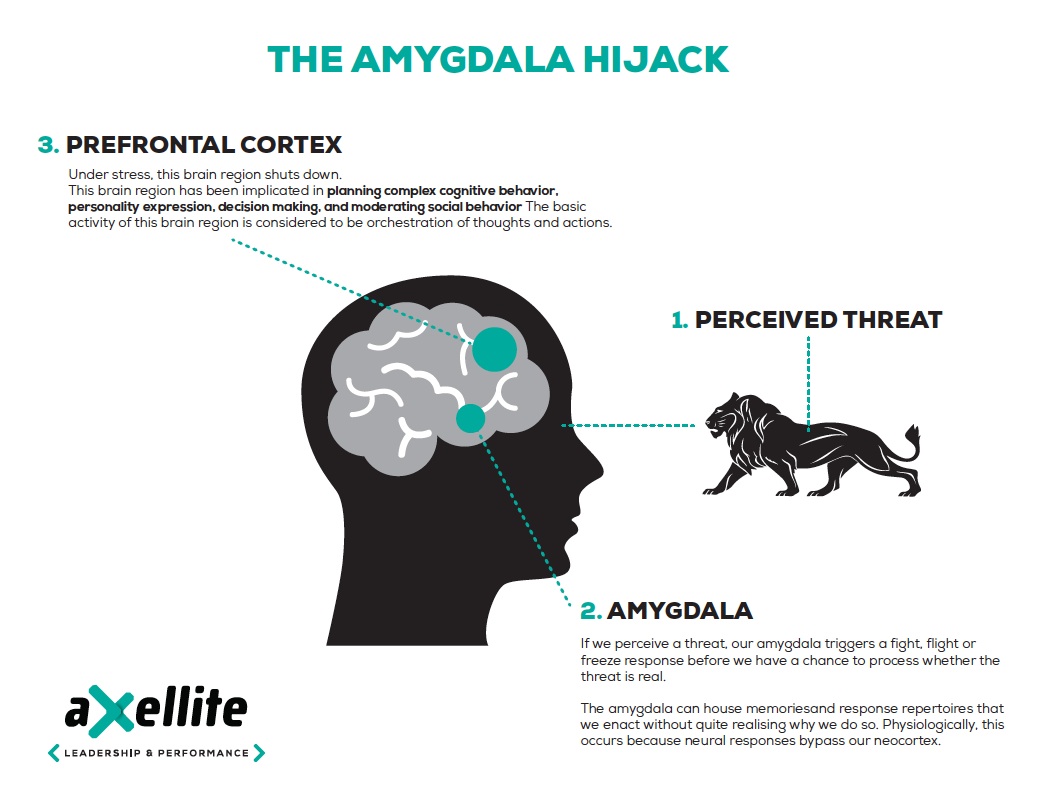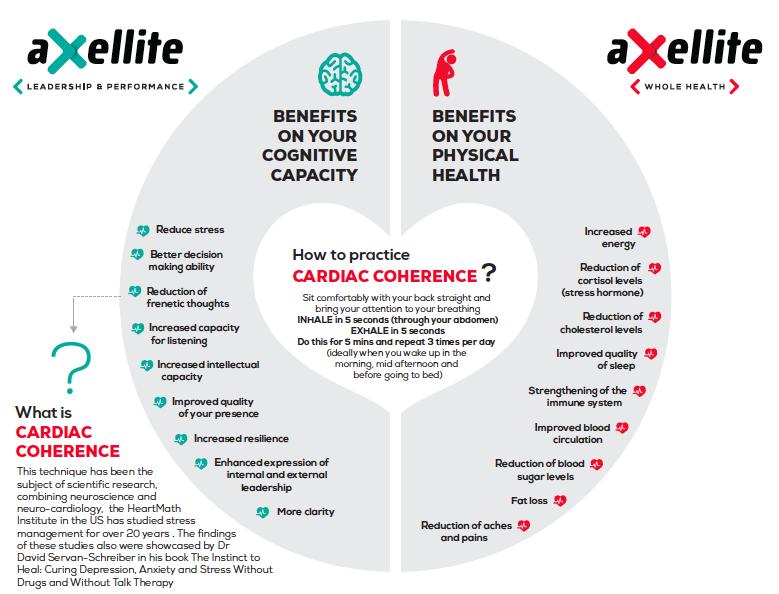An interesting observation I’ve identified from coaching several hundred leaders over the years is the correlation between stress management and health. Even more interesting, is the degree to which leaders struggle to identify when they are subject to stress. For whatever reason, I often hear: “I’m actually not that stressed”; yet because my expertise includes years of body work and health coaching, I can quickly help my clients see the links between their symptoms and the way they manage (or deny) stress. Poor stress management (or worse, denying its existence) has an incidence on: productivity, cognitive function, well-being and overall health. But why are so many people missing the mark? Let’s begin by looking at a list of symptoms related to stress:
- Lack of focus, attention and concentration
- Poor memory, forgetfulness
- Irritability/ knee-jerk reactions
- Anxiety
- Impatience
- Low energy
- Insomnia
- Digestive issues such as: stomach reflux, heart burn, constipation, diarrhea
- High blood pressure
- High blood sugar level
- Chronic pain such as: tension in the neck, lower back, rib cage, abdomen
- Difficulty breathing
- Headaches
- Depression
- Lethargy
- Heart palpitations
- Cold feet and hands
- Frenetic energy
- Biting your nails
- Clenching your jaw and/or grinding your teeth
- Addictions: chain smoking, binge eating, uncontrollable sugar craving and all other addictions

Have you ever experienced one of those symptoms before and thought that it might have to do with stress? Are you experiencing these on a daily basis? A large number of patients have come to me for bodywork, and were stunned to realize that the root of their condition is not only biomechanical but also psychosomatic[1]. After deep research on the phenomenon, I’ve come to understand that there are two reasons contributing to this “false” objectivity when it comes to assessing our own level of stress:
1) The lack of awareness of the symptoms. For example, some people have an increased sensation of hunger when they are stressed. This is explained by the fact that stress causes a hormonal cascading effect: it augments the cortisol hormone levels in your body, which causes the release of stored sugar from muscle tissue into the bloodstream, which then causes insulin to spike in your body. The drop of insulin happening after is what is causing the sensation of hunger. But most people just think they’re hungry all the time!
2) Many leaders ignore the physical warning signs of stress, as if their brain, which is their main operating tool, wasn’t connected to the rest of their body. Because we mostly live in our heads, we have become quite good at rationalizing what we are experiencing or feeling, and this is held and reinforced by a “story” we tell ourselves about who we are thus, blinding us further from reality.
The intensity and frequency at which you experience the symptoms listed above, are a good indicator of how much stress your body is going through. In this article I will describe the mechanism of stress, how it affects the body, how to increase your awareness to it, and I will teach you a technique to promote self-regulation of the nervous system. Mild stress can express itself daily in subtle ways and goes unnoticed without strong repercussions; yet over time, it can become detrimental.
What happens to the body when exposed to stress:
- The amygdala is part of the brain that is responsible for detecting danger. The amygdala is the reason we get triggered by an event that we see as potentially threatening or dangerous. The cascading effect in the body starts by the release of the stress hormone called cortisol, putting the body in a hyper arousal state ready to fight or flight. This mechanism is called « the amygdala hijack[2]» and is essential for our survival because it was designed to keep us safe from raging lions and other predators. In today’s day and age, it is improbable for must of us to have to face a raging lion chasing us down in the jungle. As a result, the amygdala is used less optimally. In today’s industrialized world, the raging lion (or threat) will look like this: relentless entry of emails and phone calls, difficult conversations at work and at home, traffic jams, public speaking, deadlines, the pressure of corporate profit, all kinds of mental fears and negatives programing (news, medias), social status, money, family drama and so on. According to a recent TED talk by Dr. Lissa Rankin[3], the average person experiences between 100 to 150 stress episodes daily (for most of us, none of these episodes are actual raging lions).
- The amygdala highjack disrupts our access to the prefrontal cortex, which is responsible for strategy, creativity, logical thinking, reasoning, self-regulation of emotions, etc. With access to this area disrupted, we are left with our automatic reactions (also called automaticity[4]), which are the strategies we learned a long time ago to combat stress. This includes strong reactions, such as yelling, criticizing, accusing, blaming others, and defensive behaviours or reactions such as withdrawal, freezing up, not speaking up, and evasiveness. These are learnt responses to threats and, for the most part, come at a high energetic cost.
- Before you can see in behaviourally that someone is triggered (with example reactions mentioned above), the very first thing that occurs is a physiological reaction. The sensations will range from the skin temperature changing, the breath becoming shallow, to the blood flowing out of the digestive track, sugar being released from the muscle tissues to prepare for fight or flight, or muscles tensing-up in different areas of the body creating energy blockages. More example physiological sensations include: burning sensation in the chest, tension in the belly, tension in the neck, pain in the lower back, clenching of the jaw, tension in the legs, nausea, sweaty palms, hot flashes, goose bumps, just to name a few.
- Following the physical reaction is the emotional reaction: guilt, sadness, fear, anger, frustration, shame, etc.
- Following the emotional sensation, thoughts arise as a way to tell ourselves the “story” or explain to our internal selves why we might be feeling the way we are (justification for the conditioned reaction). For example: Janet is in a meeting with the Vice President and her peer Jonathan. Jonathan puts forward an idea she had discussed with him and Jonathan doesn’t give Janet the credit. Janet is immediately triggered. Her neck tenses up, she is breaking into a sweat, and her heart is beating down her chest. She is feeling major anger, and her mind is telling her: “I can’t believe Jonathan didn’t give me credit, he wants to climb over me and get the attention of the VP, that is so like Jonathan, he is so hungry for power, that is totally something he would do to get ahead”. If we let the thought pattern take over the situation, it absolutely can be like putting fuel on the fire of our emotional and physiological response… and in no time, feel like we are in a reactive downward spiral.
As leaders it is important to understand that our emotions are driven by neurological impulses that cause the trigger, that then causes the cascading reaction to the perceived threat. Although these neurological impulses are beyond our control, the resulting emotions don’t have to be. When the pressure is on and emotions are running high, it can feel like something is taking over us – but that situation can be skilfully managed. The competency called self-regulation is an important characteristic of emotional intelligence and stress management; it frees us from being hostage to our impulses and thus allows us to fully express ourselves from a place of creativity versus reactivity. Now that you are aware of the cascading effect of stress, you are surely wondering: What do I do now? The most important thing to alleviate the burden of stress is to become aware of when the relating symptoms manifest and to practice self-regulation.

Practices
Here’s a practice to train your mind and cultivate the ability to notice the early warning signs of a stress episode:
Connecting to your body
Take 2-5 minutes to complete this exercise – please be in a seated position.
- Control your breathing pace to 5 seconds inhaling and 5 seconds exhaling. This will allow you to use your breath as an anchor and a way to come back to if you loose focus. Breathe in by pushing the belly button out expanding your abdomen out and breathe out by relaxing your belly.
- Then bring your attention to your feet, feeling the soles of your feet and feeling the floor below your feet. Bring your attention to the physical sensation (temperature of your skin, muscle tension, sensation of the air or your clothes on your skin, numbness, goose bumps, tickle) and notice what is happening without trying to analyse it and without trying to change anything. Just notice and observe the sensation.
- Start from your feet and move up to your lower legs, knees, thighs, pelvis, lower back, abdomen, mid back, rib cage, chest, heart area, shoulders, arms, hands, back of the head, front of the face. While doing this body scan, keep breathing steadily. To start, take about 5-10 seconds on each area of your body to notice your sensations.
- If you loose focus and start to think about something else than the exercise, make a mental note, gently bring back your attention to your breathing and begin where you remember leaving off. The goal here is to observe and connect to your physical sensations in order to increase your body’s ability to recognize the signals of a stress episode.
- This practice is training you to recognize when you have a sudden switch in physical reaction associated with stress and to allow you to self-regulate. I recommend you to practice this technique every day for at least 5 minutes.
Body scan guided meditation
You can also search the web for some help with this practice using a body scan guided meditation; many versions are available on YouTube for free. This will give you the same benefit from the described technique mentioned above and help you stay focused.
You can also use the following audio:
Audio Player
Self-regulation of the nervous system
Self-regulation is a leadership skill that has gained in popularity and importance amongst leaders over the last few years, thanks to the seminal research by Daniel Goleman, author of several books on the topic
A practice I suggest regularly is cardiac coherence. This technique has been the subject of scientific research, combining neuroscience and neurocardiology, the HeartMath Institute in the US has studied stress management for over 20 years. Dr. David Servan-Shreiber also showcased the findings of these studies in his book “The Instinct to Heal: Curing Depression, Anxiety and Stress Without Drugs and Without Talk Therapy”[5]

How to practice Cardiac Coherence?
Sit comfortably with your back straight and bring your attention to your breathing.
INHALE for 5 seconds (through your abdomen), EXHALE for 5 seconds. Do this for 5 minutes and repeat 3 times per day (ideally when you wake up in the morning, mid afternoon and before going to bed).
Click on this link and follow the steps with ease: https://www.axellite.com/cardiac-coherence-axellite-whole-health/
What should I do to see an improvement?
If you want to see a real shift in your performance, productivity, well being and health, it is important to be committed to regular practice. I tell my clients to enter into a 30-day experiment of a) connecting to their body and b) practicing self-regulation with cardiac coherence. This will require a daily 10 minutes investment.
You will be amazed at what you will discover about yourself. You are most likely to experience a significant stress reduction both mentally and physically. Observe, notice and take notes of your observations on a daily basis, to reflect back on your progression. Yes, it requires “work”; if it were easy, no one would ever be subject to their triggers. This said, it is possible to tame our reactive nature and make way for our more creative self to shine through.
Please share your results with me! I’m also available for one-on-one coaching sessions. Contact me at coach@axellite.com for information or questions.
[1] Psychosomatic: (of a physical illness or other condition) caused or aggravated by a mental factor such as internal conflict or stress.
[2] Goleman, D (2005) Emotional Intelligence; Why it Can Matter More than IQ http://www.danielgoleman.info/topics/emotional-intelligence/
[3] Rankin, L (2013) Mind over Medicine; Scientific Proof that you can Heal Yourself http://mindovermedicinebook.com/
[4] Automaticity: is the ability to do things without occupying the mind with the low-level details required, allowing it to become an automatic response pattern or habit. It is usually the result of learning, repetition, and practice.
[5] Servan-Schreiber, D (2004) The Instinct to Heal: Curing Depression, Anxiety and Stress Without Drugs and Without Talk Therapy https://www.amazon.ca/Instinct-Heal-Depression-Anxiety-Without/dp/1594861587